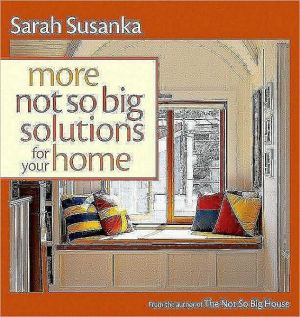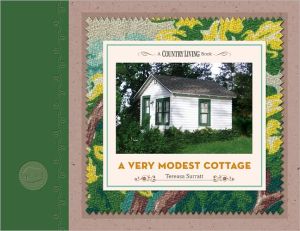More Not So Big Solutions for Your Home
Readers simply cannot get enough of Sarah Susanka. Homeowners are certain to embrace this new collection of articles by the best-selling author and visionary residential architect who sparked a movement toward “better, not bigger” homes. Practical solutions abound in this creative reference – everything from how to use color and unify an interior with trim to finding space for an “away room” and designing a laundry room that works. Susanka poses – and clearly answers – such questions as “How...
Search in google:
Readers simply cannot get enough of Sarah Susanka. Homeowners are certain to embrace this new collection of articles by the best-selling author and visionary residential architect who sparked a movement toward “better, not bigger” homes. Practical solutions abound in this creative reference – everything from how to use color and unify an interior with trim to finding space for an “away room” and designing a laundry room that works. Susanka poses – and clearly answers – such questions as “How much space do you really need?” and “Where does the garage belong?” Written in her engaging conversational style and illustrated with her own inviting sketches, this collection of attainable home improvements is a valuable addition to any smart and thoughtful homeowner’s library.
more not so big solutions for your home\ \ By Sarah Susanka \ The Taunton Press\ Copyright © 2010 Sarah Susanka\ All right reserved.\ ISBN: 978-1-60085-148-3 \ \ \ Chapter One\ By Design \ When an architect begins to think about a new project, whether it's a remodeling, an addition, or a new home, there are a few design considerations he or she must address before doing anything else. These broad-based considerations-from how to allow for natural light to what kind of living space you need-are often overlooked by people not trained in architectural design, and yet they are important because they provide a point of orientation for the rest of the home's design.\ For example, let's say you are planning to build a new home on a relatively small lot in an inner-ring suburb. The neighboring houses are mostly two stories and built between the 1920s and 1940s; there are no alleys in the area, so driveways typically run along one side of each lot to access a detached garage at the back. This setup gives the neighborhood a distinct flavor, and integrating the new home seamlessly into its environment requires thoughtful design. The new home will have some different features than its older neighbors, but it must still be designed to look like one of the pack if it is to fit in.\ Perhaps you really want an attached garage. While there are no rules to prohibit a garage on the front of the house, facing the street, to place the garage there would be an anomaly and most likely an affront to the neighbors. So the architect's job is to figure out a way to include the attached garage the homeowners want but tuck it away on the back of the house and provide access from a driveway that looks very much like the other driveways on the street.\ This type of thoughtful attention to the characteristics of the existing neighborhood is one example of the kind of design thinking that gives an architect the ground rules for proceeding with the plans for the home. The five broad-brush issues we'll look at here will give you a sense of how to orient yourself to your own design challenges and teach you how to think like an architect as he or she begins the work. Although the challenges presented here aren't the only ones to consider when beginning a new design project, they will help you to make the most of your budget while tailoring your home to fit your household, your activities, and your aesthetic and functional requirements to a tee.\ Designing for Our Human Scale\ It's obvious that houses are built for people, but what's not always so apparent is that good residential architecture is designed for our human scale. What exactly does that mean, though? Human beings come in a variety of shapes and sizes, so in home design a "one size fits all" approach won't work. But sadly, in residential construction today, with our love of bigness, houses have become vast in almost every direction. While these houses are impressive in a photograph, they are difficult to settle into because they're simply too large. It may be desirable to design a public building so that its visitors feel insignificant and awed by its scale, but that's hardly what we want for our own homes.\ Before you start building or adding on, it's important to understand how to design spaces that will allow most people to feel comfortable. There are some standards and conventions with respect to the heights of things inside the house that can help us to tailor interior spaces to fit our bodies. The heights of windows and countertops are perfect examples.\ Door and window heights\ It is conventional to make the head of a standard doorway 6 ft. 8 in. above the floor. The tops of windows are also typically located at this height. In fact, I like to make both doors and windows exactly the same height off the floor so that all the heads (the tops) align perfectly. This looks more orderly and allows you to run a continuous trim band above them if you want to, tying them all together.\ There aren't any conventions about windowsill heights though. Often they are located too high to see out of comfortably when you are sitting down. There are thousands of eat-in kitchens and breakfast nooks around the country that would be lovely spaces but for the height of the windowsill, which puts the sitter just out of eyeshot of the backyard or the view beyond.\ To fix the problem, the key is to locate the sill sufficiently lower than your eye height so that when you are sitting on the far side of the table, you can still look out and down. My favorite sill height is about 2 ft. 4 in. from the floor to the bottom of the glass. When the sill is 3 ft. off the floor, you're definitely limiting access to exterior views.\ The same sill height is desirable in a bedroom or a bathroom where you want to be able to see a view from the bed or the tub. Of course, this is recommended only for places where there's plenty of privacy from neighbors, or where you have window coverings that can obscure the lower part of the window if necessary.\ Higher windowsill heights are needed where privacy is important-for instance, in most bathrooms-or where view does not matter and the window is simply there to let light in-maybe above a bed. In these situations, the best sill height is just above chest level, so you can still see out when you are next to the window without revealing any body parts that you don't want to show off to the neighbors.\ At kitchen countertops, I like to bring the windows down as close as I can to countertop height so that the view is maximized. A 4-in. backsplash behind a standard countertop makes the windowsill height about 3 ft. 4 in. off the floor. You can also take the sill all the way down to the countertop height, which is usually 3 ft. off the floor.\ Countertop and cabinet heights\ In kitchens, most appliances are made to fit beneath a countertop that's 3 ft. off the floor. Therefore, this is the typical kitchen work surface height. Although it's not ideal for someone taller or shorter than average, it seems to satisfy most people most of the time. I've had many clients request either a taller or a shorter countertop, but I usually encourage them to stay with the standard 3-ft. height for the primary work areas. What's right for one homeowner may not be right for the next buyer of the home, and the need to replace all lower cabinetry in a kitchen can drive potential home buyers away.\ Adding a lowered or raised section to an island or peninsula is a good alternative. A baking-center countertop that's 3 in. to 4 in. lower than usual makes kneading dough and rolling out pastry easier. And a small section of raised countertop can work well even for a short person, for setting out ingredients and items that are not currently in use. For the taller person, this will be the preferred food preparation area. All this may seem an exaggerated concern for anyone in the middle of the height spectrum, but for those taller or shorter than average it can make an enormous difference in convenience and comfort.\ Upper cabinets pose another challenge. I've heard from many shorter clients that upper cabinets are not very useful because they are simply too high. For this reason, I'll typically locate the upper cabinets 15 in. above the countertop, even though the convention today is often higher. Because the upper cabinets are shallower than the lower ones, and therefore don't obstruct the work surface below, the 15-in. height makes more of the cabinet area accessible to most people.\ Ceiling heights\ Because 2x4s, the most common building materials for residential construction, come in standard lengths of 8 ft., 9 ft., and 10 ft., most ceilings are one of these heights. In our love of spaciousness, ceiling heights have risen rapidly over the past two decades, and many houses today are built with 10-ft. studs. Although there is nothing inherently wrong with ceilings of this height, if the entire house is this tall, you can end up feeling somewhat diminutive yourself and often less comfortable. So I recommend always varying the ceiling heights-having places that are shorter, from 7 ft. to 8 ft. tall-as a contrast to the taller ones.\ My preference is the standard 8-ft. ceiling, with some select lower-ceilinged areas, because it is closer to the heights of our human bodies and so is human scaled. Since it's also generally a little less expensive to build with 8-ft. studs than 9-ft. or 10-ft. studs, I prefer to save the money on height and add some special features with the money that's saved.\ In recent years, 8-ft. ceilings have gotten a bad rap and are often thought of as boring, but they are only boring when the ceilings are the same height throughout the house. An all 9-ft. or all 10-ft. ceiling is just as bad. It's the variety that makes the house feel comfortable as well as interesting.\ If you are planning a vaulted or cathedral ceiling, make sure the height of the peak doesn't overpower the size of the room. If you lower the spring line-the height of the vertical sidewall-the overall proportions of the room can feel significantly more appropriately scaled for our bodies. If you've ever visited a Cape Cod style house, you'll know what I mean. With a spring line of from 4 ft. 6 in. to 6 ft., the rooms on the upper level of such a home feel comfortable; the same-sized room with a higher spring line starts to feel more "cathedral" like, literally, which isn't a comfortable proportioning for a sleeping room.\ Start taking note of the heights of things that you feel comfortable with. It's only by noticing how you feel in relationship to the heights of surfaces around you that you can replicate that scale in your own home. Your own body is your best gauge of what feels appropriately scaled to you.\ How Much Space Do You Really Need?\ After having written the series of Not So Big House books, I get a lot of questions from people who want to know how much house is enough. They want rules and standards by which to gauge the right amount. But you can't define space this way for two reasons. First, a house that has a sense of home has almost nothing to do with square footage; and second, Not So Big means building a house about a third smaller than you thought you needed with dollars reapportioned out of square footage and into quality and character. Both of these points are intended to take the focus off quantity and place it firmly on the things that affect livability.\ So where do you start, and how do you know whether the amount of space you are living in or plan to live in is not too big, too small, or just right? The following rules of thumb will help you determine whether it's more quantity of space you need or more quality you're really seeking. Although the answer is usually a combination of the two, our typical solution these days is to favor more quantity over more quality, when almost always it's an increase in quality of living environment that really makes us feel more comfortable and more at home.\ The challenges related to figuring out how much space you will need in a new home are significantly greater than determining space needs when remodeling. The reason for this is that the homeowners of the house to be remodeled can pinpoint right away what works and what doesn't in their existing home. Although they may not be able to devise the perfect solution, they can see the problems they're facing with great clarity. Their challenge is to avoid jumping to the most obvious and simplest solution to their problems, which is almost always too big and which frequently spoils the character and utility of the existing space.\ To orient and ground the discussions, let's take two households as examples, one of which plans to remodel and one that plans to build from scratch.\ Remodeling to incorporate Not So Big\ John and Cindy live in a fine old Victorian with their three young children. The house is beautiful, but most of the space on the main floor is poorly suited to their needs. They spent most of their time while at home either cooped up in the inhospitable kitchen or sitting around the formal dining room table, inherited from Cindy's mom, worrying all the while about whether the children would damage it.\ They wanted a new kitchen, an informal eating area, a place for their kids to play or watch TV while Cindy is in the kitchen, and an in-home office on the main level. Since John and Cindy are both tall, they love the 10-ft. ceilings throughout the house. And they want whatever additions they make to match the character of the rest of the house. The remodeled floor plan involves very little additional square footage, but it does give the family lots more room (illustrations above and facing page).\ Building a new Not So Big house\ For a couple thinking about a new home, the plans they look at on paper typically don't give them enough information to gauge what the space will feel like when construction is complete. Reading plans is one thing, but lots of people have a hard time visualizing, for example, how big a 14-ft. by 16-ft. room will feel.\ Because there's an almost universal fear of feeling too cramped-what I have termed "fear of too smallness"-would-be homeowners tend to make everything a bit bigger than their favored plan suggests, just to be on the safe side. This is one of the primary reasons our culture's new houses have tended to keep escalating in size, with the result that a lot of households find themselves at sea in an ocean of space that is never too small but also never too comfortable.\ In this example of building new, the Winston family wanted a house with more character. They also wanted a layout that would make family interaction easier during food prep but that would still allow them to do different activities, such as homework or reading, within a shared living space so they could still be together as a family.\ Doug and Julie Winston and their 13-year-old daughter, Laura, lived in their existing house for a dozen years before deciding to build a new house. Although there was enough space in it for three, the kitchen offered little counter space and no place to eat without retiring to the dining room. They like to entertain, so they wanted a dining room that could be used to serve two to four guests. And the living room, while large, was not used much because it's not in the primary circulation path through the house. Instead, the den, which opens off the dining room, became their primary living space. They liked it because its size is comfortable for the three of them to gather and socialize.\ The new house, illustration above, solves the problems in their previous house and gets rid of unused rooms. The multiuse spaces are welcoming and appropriately sized; changes in ceiling height help to define boundaries in the mostly open floor plan.\ What Is an Open Plan and Why Does It Work?\ Open plan is a term coined by Frank Lloyd Wright to describe his revolutionary approach to home design. For centuries, houses were made up of boxes (rooms) connected by doorways and hallways. Wright spoke of the "destruction of the box"-eliminating walls on the inside to create spaces that flowed inside and outside to become one continuous, organic space. He suggested that instead of each function in the house being enclosed in its own separate box, rooms could be opened wide to one another. Light would filter from one area to another, circulation between areas would improve, and spaces would no longer be defined by one term, like "living room" or "dining room." Spaces would be differentiated from each other with changes in ceiling height, as well as with framed openings and columns, rather than with walls alone.\ The kitchen becomes acceptable\ You can see the beginnings of Wright's new vision for a house in his early work. Often a living room, dining room, and entry hall all opened gracefully into one another, so that from each space it was possible to see what was going on in the others (illustration facing page). Even more revolutionary was Wright's introduction of the kitchen as part of the open plan in his Usonian houses, beginning in the 1930s. Until this time, kitchens had been kept well out of sight, along with all the smells of kitchen preparation and cleanup. The advent of good kitchen ventilation technologies changed all that, and Wright was the first architect to take advantage of its benefits.\ Varied ceiling heights are key\ What made Wright's open-plan houses work so well was his use of architectural elements to differentiate one area from another, especially his use of varied ceiling heights. Without this variation, a house with an open plan can be pretty dull.\ (Continues...)\ \ \ \ \ Excerpted from more not so big solutions for your home by Sarah Susanka Copyright © 2010 by Sarah Susanka. Excerpted by permission.\ All rights reserved. No part of this excerpt may be reproduced or reprinted without permission in writing from the publisher.\ Excerpts are provided by Dial-A-Book Inc. solely for the personal use of visitors to this web site. \ \
1 By Design How Much Space Do You Really Need? Designing for Our Human Scale What Is an Open Plan and Why Does It Work? Let There Be Light Where Does the Garage Belong? 2 Room by Room Rethinking the Formal Living Room and Dining Room Designing a Comfortable Guest Room Rethinking the Informal Eating Area Squeezing in a Half-Bath Designing a Front Porch 3 Attention to Detail When a Room is Too Tall Column Proportion: Bigger is Usually Better Locating Smoke Alarms and Security-System Sensors Zero-Clearance Fireplaces: How to Make One Look Like a Million Bucks Unify an Interior with Horizontal Trim 4 Make It Personal How to Pick and Use Color Designing an Away Room Designing a Breakfast Nook Make Your House an Expression of Yourself Designing a Welcoming Entry 5 Practical Matters Getting Creative with the Bathtub and Shower Designing a Laundry Room That Works Where to Put the TV Designing a Kitchen Island 6 Living in the Real World Make Room for Privacy Make Your House More Energy Efficient Living with Extended Family Good Additions Make Good Neighbors The New Heart of the Home








